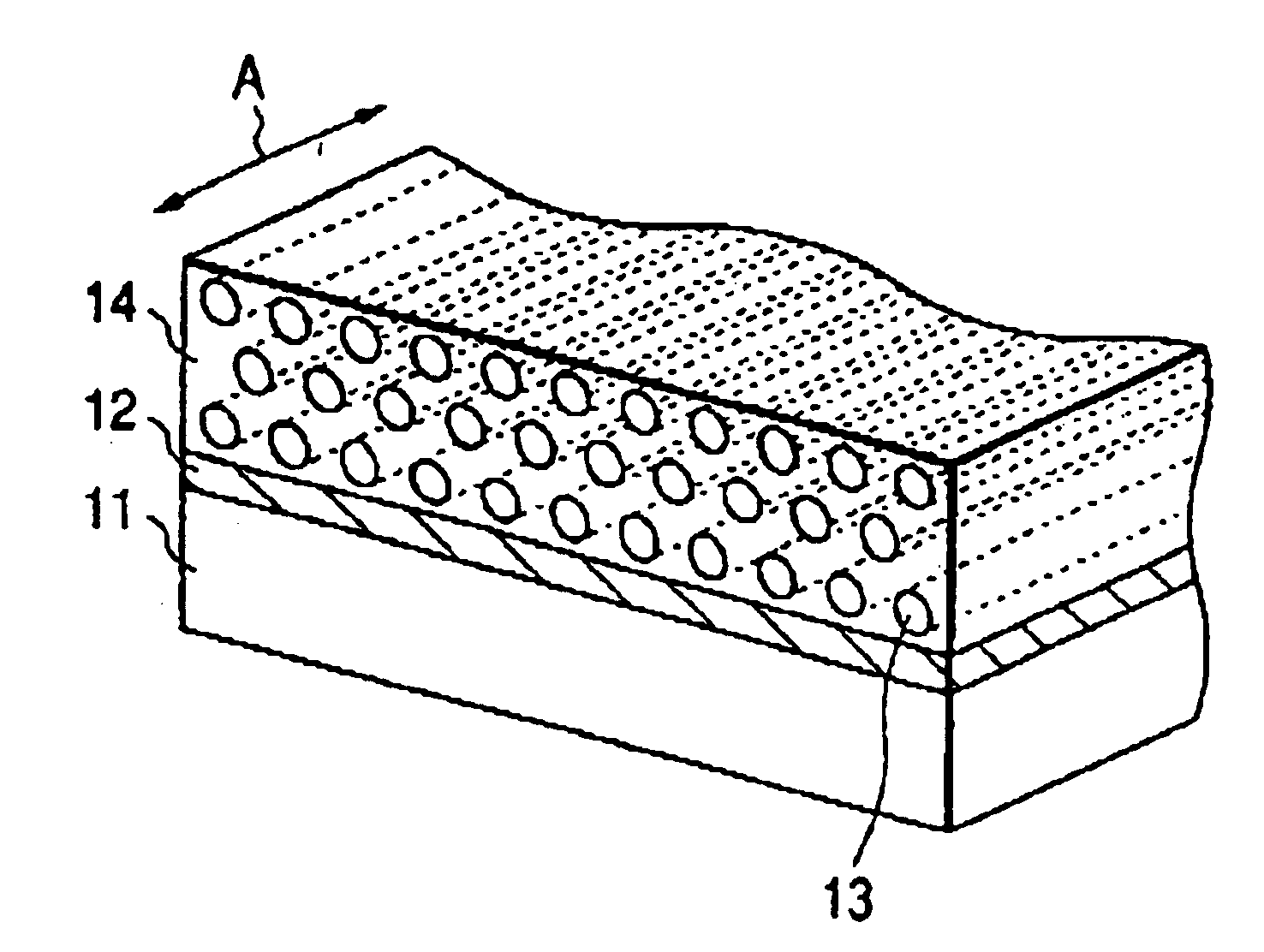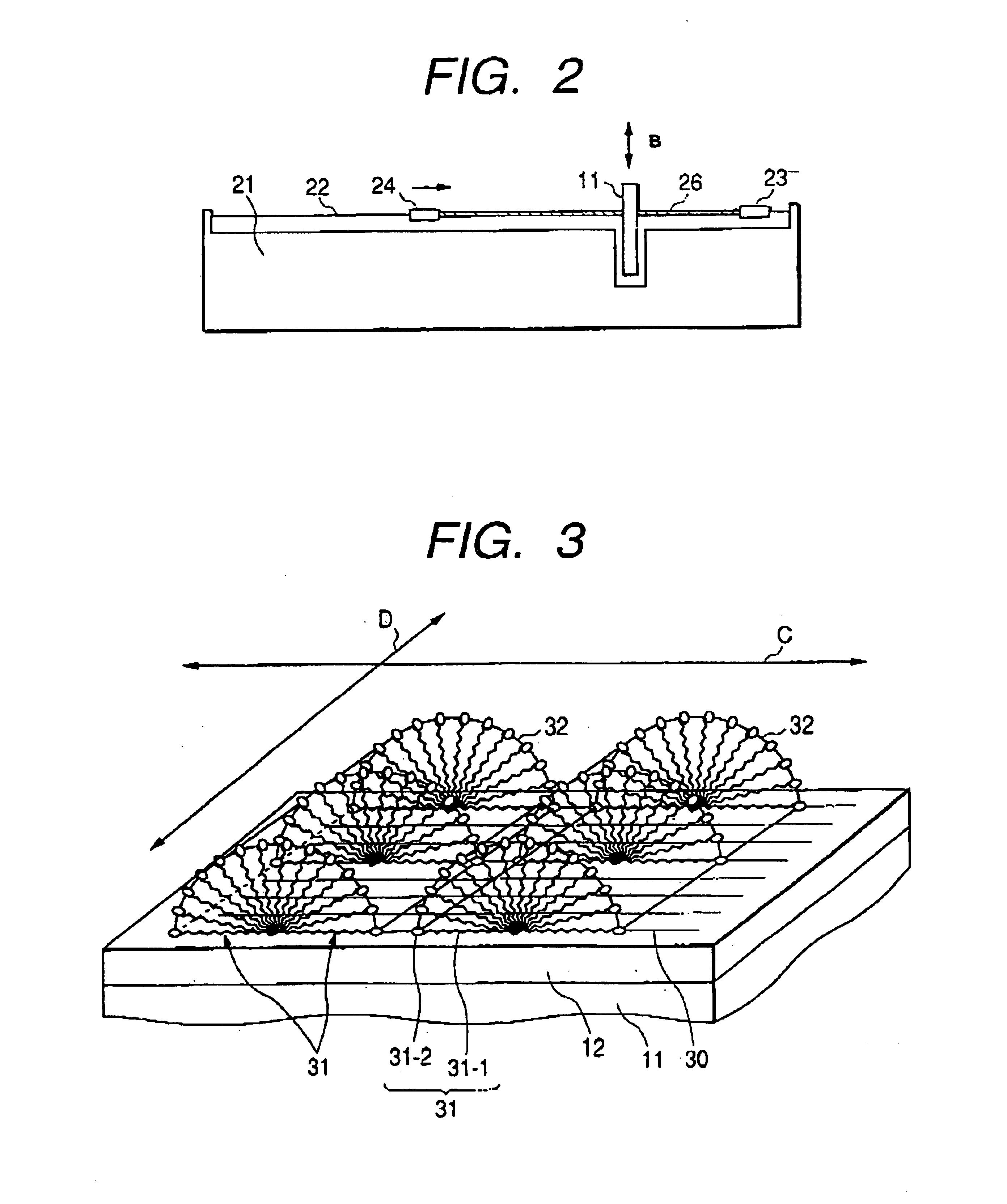Mesostructured materials, silica mesostructured materials, preparation methods thereof and control method of mesopore orientation
a technology of silica mesostructured materials and mesopore orientation, which is applied in the field of mesostructured materials, can solve problems such as the control of pore size, and achieve the effect of easy control
- Summary
- Abstract
- Description
- Claims
- Application Information
AI Technical Summary
Benefits of technology
Problems solved by technology
Method used
Image
Examples
first embodiment (
Arrangement of Mesostructured Material on Polymer Film with Rubbing Treatment)
Each of FIGS. 1A and 1B is a schematic oblique view of the mesostructured material of one embodiment of the present invention. In FIGS. 1A and 1B, reference numeral 11 is a substrate material, 12 is a polymer film and 14 is a mesostructured material arranged on the surface of the polymer film 12, and the mesostructured material 14 has tubular mesopores 13. Further, FIG. 1A shows a constitution where the surface of the film 12 has islands of mesostructured material 14 and the surfactant exists in the mesopores 13. FIG. 1B shows a constitution in which the mesostructural material 14 exists on the surface of the film 12 and the materials in mesopore 13 has been removed. The mesostructured material 14 has the tubular mesopores 13, which are oriented in a prescribed direction (direction of arrow A in FIGS. 1A and 1B) parallel to surface of the polymer film 12. The surface conditions of the film 12 contacting th...
example 1
In this example, an oriented mesostructured material was prepared using a substrate subjected to a rubbing orientation treatment of the polymer thin film.
A silica glass substrate was washed with acetone, isopropyl alcohol and pure water, and the surface was cleaned in an ozone generator. Then, the NMP solution of polyamic acid A having the structure represented by the following chemical formula (iv) was spin-coated on the substrate, followed by a thermal treatment at 200° C. for one hour to convert to polyimide A represented by the following chemical formula (v).
Then, the substrate thus formed was treated by rubbing under the following conditions:Rubbing conditions for polyimide A:Cloth material: nylonRoller size: 24 mmPress amount: 0.4 mmRotation speed: 1,000 rpmStage movement: 600 mm / sRepetition: twice.
An acidic solution of surfactant was prepared by dissolving 2.82 g of cetyltrimethylammonium chloride in 108 ml of pure water and adding 48.1 ml of 36% hydrochloric acid to it foll...
example 2
This Example 2 is a preparation example of the mesoporous silica where the surfactant is removed by solvent extraction from the mesostructured silica formed on the substrate. By using the silica glass substrate on which polyimide A film was formed and rubbed as in Example 1, the mesostructured silica material was deposited on the substrate by using the same solvent composition and the same procedure as in Example 1.
When this mesostructured silica material is soaked in ethanol at 70° C. for 24 hr, more than 90% of the surfactant was removed from mesostructured silica material by one extraction. When the extraction was carried out twice, more than 95% of the surfactant was removed from the sample. After extraction, the thin film was dried to remove ethanol and the mesoporous silica was obtained.
This method of removing the surfactant micelles by solvent extraction used in Example 2 is an effective method for removing the surfactant from the mesostructured silica formed on the substrate...
PUM
| Property | Measurement | Unit |
|---|---|---|
| pore sizes | aaaaa | aaaaa |
| pore sizes | aaaaa | aaaaa |
| pore sizes | aaaaa | aaaaa |
Abstract
Description
Claims
Application Information
 Login to View More
Login to View More - R&D
- Intellectual Property
- Life Sciences
- Materials
- Tech Scout
- Unparalleled Data Quality
- Higher Quality Content
- 60% Fewer Hallucinations
Browse by: Latest US Patents, China's latest patents, Technical Efficacy Thesaurus, Application Domain, Technology Topic, Popular Technical Reports.
© 2025 PatSnap. All rights reserved.Legal|Privacy policy|Modern Slavery Act Transparency Statement|Sitemap|About US| Contact US: help@patsnap.com



